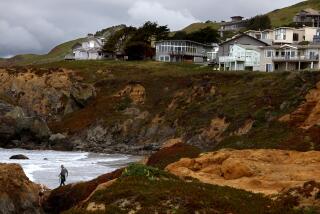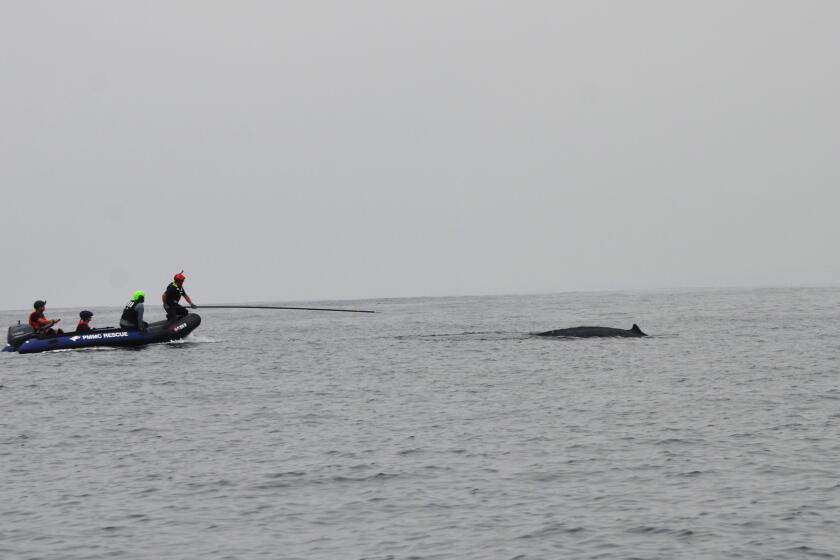In reversal, staff of Coastal Commission recommends approval of Newport Beach hotel and housing project

In a reversal of its previous position, the staff of the California Coastal Commission is recommending approval of a hotel and housing complex on the last big block of private land on the Southland coast.
The proposal to build an upscale hotel, retail space and hundreds of homes on a coastal bluff next to Newport Beach has helped stoke the controversy surrounding the commission, which was created to guard against over-development of the state’s famous coastline.
Commissioners last October brushed aside a staff recommendation to reject the Newport Banning Ranch project and questioned the staff’s environmental evaluations of the 401-acre oil field.
A few months later, the panel fired its executive director in a move that many condemned as an effort to make the commission more receptive to coastal development.
The staff report, released Friday in preparation for a May 12 hearing on Banning Ranch, is bound to add to the furor, pleasing neither opponents nor the developers.
The staff says commission approval should be conditioned on a number of changes to the project, which calls for nearly 900 homes, a 75-bed resort hotel and 45,000 square feet of retail space.
The fight over Banning Ranch revolves around how much of it is Environmentally Sensitive Habitat Area, or ESHA, a state Coastal Act designation that courts have ruled precludes housing development.
Despite its seven decades as an active oil field, the tract boasts wetlands, coastal sage scrub, grasslands and seasonal pools that provide a refuge for plants and wildlife that have all but disappeared from the Southland’s heavily urbanized coastline — including the threatened California gnatcatcher and the endangered San Diego fairy shrimp.
The Coastal Act bars development of the site’s extensive lowland marshes, which flank the mouth of the Santa Ana River and make up much of the project’s proposed nature preserve. The hotel, housing and retail space would be clustered on an upland mesa that the staff last year concluded harbored significant amounts of sensitive habitat.
But where the staff saw a valuable and rare coastal ecosystem, commissioners who toured the site saw old oil pipes, rusty tanks, piles of rubble and a brownfield in need of a cleanup that would be part of the project.
At the October hearing, commissioners directed the staff to work with the development team to devise an acceptable project. Newport Banning Ranch LLC reduced the proposed building footprint, trimming the retail space and cutting the number of homes from 1,175 to 895. It also boosted the nature preserve to 310 acres.
Staff ecologists went back to work, revisiting the site several times and reviewing field data. They remapped the environmentally sensitive areas, reducing the number of seasonal pools and areas of purple needle grass. But they expanded California gnatcatcher habitat. All told, the amount of sensitive habitat declined, increasing the amount of land available for development from about 19 acres to 55.
That is still substantially less than what the developers want. And the staff is recommending conditions that would eliminate a section of the main road and some residential units.
“The current proposal would still extend far into, and thereby destroy large swaths of ESHA and wetlands identified on the site, and it therefore continues to be inconsistent with the resource protection policies of the Coastal Act,” states the report.
Newport Banning Ranch executives were not immediately available for comment.
Robb Hamilton, an environmental consultant for a group that opposes the project, complained that the new staff recommendations allow too much development. “It’s not preserving the ecosystem. It’s fragmenting and developing it,” he said.
Some 400 abandoned oil wells are scattered across Banning Ranch. But the field’s oil reserves aren’t exhausted. Project plans call for operators to continue oil production on two well clusters totally 15 acres.
The development partners, which include an oil company and an investment firm, say they will have to spend $30 million cleaning up the tract, which has been closed to the public since oil production began in the 1940s.
State law requires remediation when a field is played out. But project proponents argue that unless the development is approved, it could be decades before the land is restored and the public gains access.
The organization Hamilton represents, the Banning Ranch Conservancy, would like to buy and preserve the tract but acknowledges it doesn’t have the funds to do so.
Although the Newport Beach City Council approved a larger version of the project several years ago, surrounding neighborhoods turned out in force at the October hearing to oppose the development.
Friday, a public information officer said email comments were landing in the commission’s inbox at the rate of a dozen a minute. Some 1,700, many of them form letters, opposed the Banning Ranch development and 30 were in favor.
Twitter: @boxall
ALSO
Plaschke: Lakers go back to a sweet spot with hiring of Luke Walton
Trump protesters, Mexican flag-wavers could bring unintended consequences for GOP race
May Day, Trump, Sanders: LAPD braces for weekend of political protest
More to Read
Get the Latinx Files newsletter
Stories that capture the multitudes within the American Latinx community.
You may occasionally receive promotional content from the Los Angeles Times.







